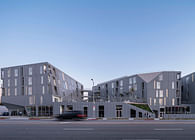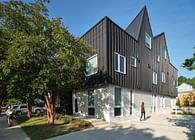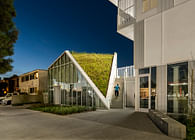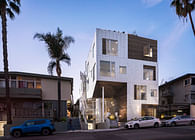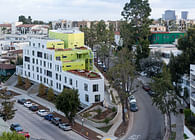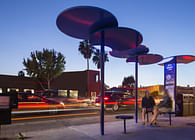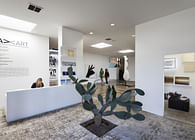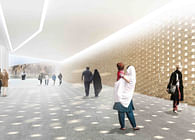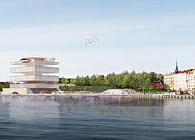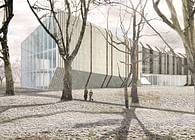
Los Angeles, CA
In 2015 LOHA was invited by Quicken Loans’ development arm, Bedrock Detroit, to design four buildings as part of their “City Modern” project area within the historic Brush Park neighborhood north of downtown Detroit. Originally developed in the 1850s for Detroit’s affluent classes, the neighborhood is home to many notable architectural features, including Victorian-era mansions. Through the city’s economic challenges and white flight throughout the 20th century, the neighborhood struggled with maintenance and disrepair. In collaboration with a diverse team of architects, including LOHA, Bedrock Detroit’s “City Modern” project aspired to revitalize the neighborhood in a manner that was both contextual and forward-thinking.
City Modern is the first large-scale housing development in Detroit since Mies van der Rohe’s tour de force, Lafayette Park, in 1956. 65 years later, Lorcan O’Herlihy’s work in housing advances a more intuitive built environment; considerate architecture that informs as much as it inspires. Instead of leveling and displacing an entire community, as the Modernist Lafayette Park did, Bedrock Detroit’s studies of Detroit, in collaboration with LOHA, suggested the streets that border City Modern were opportunities to disclose connections between the new development and the surrounding landscape: threading the new Brush Park into the existing urban fabric. Serving as a bridge between downtown and midtown while introducing much-needed density to Detroit’s housing inventory. The design and development teams viewed this project as a platform to further expand the idea that buildings should be carefully woven into city life. In City Modern, Lorcan O’Herlihy saw a Brush Park reinvigorated, a new rich tapestry that could allow urban experiences to permeate through boundaries– simultaneously diffusing and enhancing the natural tensions that exist between opposing urban conditions; exposing contrasts and compliments, rather than walled-in conflicts.
The four LOHA buildings within City Modern are sited at key corner intersections that frame the overall master plan. The quartet of buildings are variations on a single idea, meant to reflect the low-slung character of the neighborhood. The project adds density while valuing the architectural past. Inspired by Detroit’s urban palette, each of the four buildings is clad in materials commonly found throughout the city – brick, wood, and metal. Coupling one of these signature materials with a unique form gives each building its own spirit and adds aesthetic diversity to the comprehensive Brush Park neighborhood study.
Our John R. project, the first of our quartet to rise up out of the development. It steps up in height, ranging from three to five stories, referencing not only the variety of different types of buildings within proximity downtown, but also the proximity to single family, residential adjacencies, specifically, the historic Victorian across the street.
Detroit’s rich material palette inspired us to wrap the building in a rhythm of thin vertical boards of western red cedar and floor-to-ceiling windows. The wooden pieces bring texture; the glass brings openness for the ground-floor retail. Horizontals and verticals on the façade, is expressed as a series of horizontal bands at each floor that are reinforced by a metal coping detail at each floor level. The use of dark mullions, additionally offer contrast against the wood, while metal panels above and below the windows, further reinforce that the vertical break of the window is continuous.
The main residential lobby entrance is at the southern end of the building on John R Street, which is situated alongside the retail units that occupy most of the ground floor plate. On the exterior of the building along John R Street and Alfred Street, the building carves in creating an overhang of the second level which cantilevers out over the street. By expanding the bandwidth of the sidewalk, we create a lively pedestrian thoroughfare and provide shade and shelter from the elements.
The project’s sustainable goals were as much social and economic as they were environmental. The project is sited along the Qline light rail route, offering residents convenient access to downtown Detroit. On the third floor is a shared roof deck oriented across the street from the historic mansion, allowing the residents to enjoy surrounding city views, cross ventilation, and shared green space. The building’s massing provides opportunities for the installation of future roof decks in the upper levels, which will be informed by observations of occupancy patterns and circulation. At the upper level residential units, there’s a mix of studios, one bedrooms, and two bedrooms ranging from 450 – 1000 sq ft, efficiently organized with wet cores against the central corridors to maximize solar exposure to the main living spaces. An important feature that brings openness and light to the interiors, is floor to ceiling glazing and nine and a half foot ceilings.
We hope that our projects at Brush Park will be a model for revitalizing an urban district. While the neighborhood and its challenges are unique to Detroit, Brush Park can be a case study for forging paths for neighborhood growth, restoring urban fabric after decades of decline and integrating landscape and public spaces – a sign of hope for the future of the city.
Status: Built
Location: Detroit, MI, US
Firm Role: Architect
Additional Credits: Principal-in-Charge: Lorcan O'Herlihy
Project Lead: Noelle White, Matthew Biglin
Project Team: Ryan Caldera, Nick Hopson, Nicholas Muraglia, Cameron Overy, Lucia Sanchez-Ramirez, Lyannie Tran
Project Assist: Anna Hermann
Landscape Architect: Hamilton Anderson Associates
Civil Engineer: Giffels Webster
Structural Engineer: SDI Structures
MEP: Strategic Energy Solutions
Photography: Jason Keen












